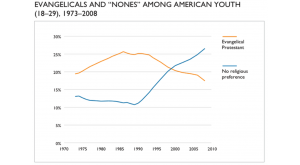I recently came across a fascinating graph in some research I was doing for a presentation on science and evangelical Christianity. The graph, which maps out Pew Research data on the decline of young evangelicals (ages 18-29) and the rise of the “nones” in that same age group. For anyone–possibly living underground–who might not know about the nones: they are the religiously unaffiliated; those who, when asked on demographic surveys to identify their religion of preference, simply click none. Interestingly, the nones are not atheists: only a small percentage of Americans (4-6% or so) are atheists or even agnostics. In fact, only half of the nones are the infamous “spiritual but not religious” crowd. The other half are “spiritual and religious,” but their religious identification is loose and often eclectic–too much so for them to comfortably identify with any particular institutional religious expression.

The graph shows the stark decline of young self-identified evangelicals and the sharp rise of the “nones.” The lines suggest these groups are like ships passing, and as they pass, more and more young Americans are jumping from the Evangelical ship to the Unaffiliated; leaving the familiar but increasingly stale waters of evangelicalism for the adventurous waters of a more postmodern and more socially and theologically progressive faith. Granted, this single, simple graph doesn’t spell out the details of the whys and wherefores. But when you take a look around at other statistics reflecting the decline in fundamentalist biblical literalism, the rise (mostly) among younger Americans in progressive politics, theology and morality, and the general disaffection with Christianity (for lots of reasons), it’s not difficult to connect the dots.
As I see it, there’s a pretty strong challenge here for leaders of evangelical churches and institutions to think deeply about what this trend means for the future of American evangelical Christianity–indeed, Christianity on the whole. Of course, globally, we are witnessing the continued rise of Christianity; my reflections here pertain to what is happening within American evangelicalism. In any case, I have serious doubts that such a rethink will actually take place from within the well-established institutions of traditional evangelicalism. Their listening ears are tilted toward the older, more powerful (and wealthier), and more conservative constituency. Alternatively, then, this creates an opportunity for more inclusive, more creative , and more flexible churches and institutions to welcome these disaffected former evangelicals who are still looking for communities and contexts within which to live out their faith authentically, honestly, and passionately.











